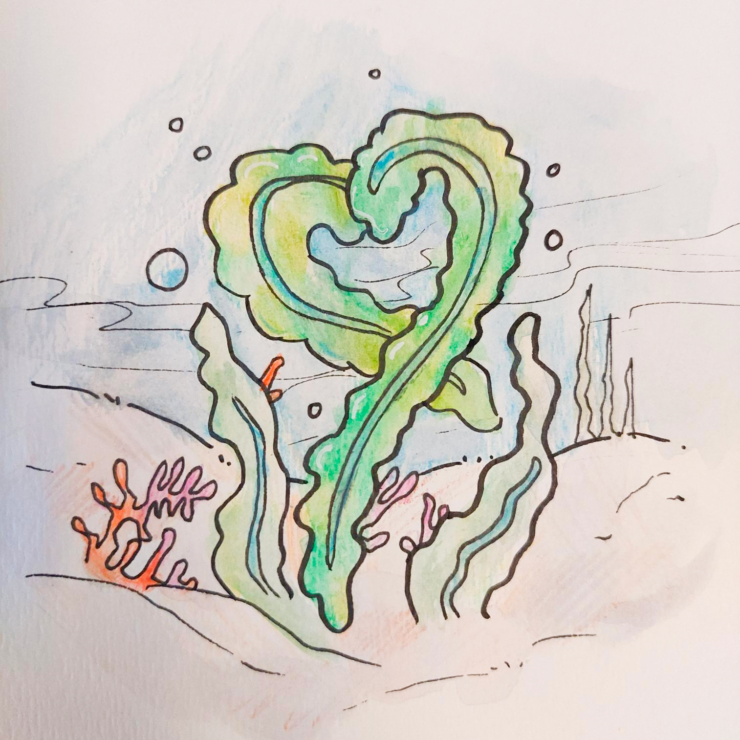The seaweed industry is taking off with applications in carbon, cuisine, and… cow farts?

Everyone has a perspective on seaweed. To some, it’s the slimy stuff on the shore that washes up in piles after a storm, to others, it’s a tasty snack, and to others it is the future.
Seaweed is the term for macroalgae and it grows in the cold, nutrient rich waters of upwelling zones found on the east coasts of the oceans. It functions as a habitat for many — if you’ve seen My Octopus Teacher then you know how beautiful and diverse an ecosystem kelp, a type of macroalgae, can support.
Many studies have shown seaweed’s benefit to biodiversity. Just by existing they function as shoreline protection, buffering the strong waves of storms and reducing erosion among other on-land effects and ecosystem services.
Seaweeds grow fast, as fast as 60 cm per day for some species. Not only that, but they are very low maintenance and able to grow from just the nutrients in the water. That makes them a very sustainable resource that has also been shown to store away large amounts of carbon — up to an estimated 173 million metric tons of carbon per year!
In addition to that, seaweeds can also contain many useful things like collagen, amino acids, carbohydrates, fats, protein, vitamins, or trace elements like iron, meaning it has huge potential to be useful in other ways. Food is a major current-day use for macroalgae as it’s very nutritious.
Many Indigenous peoples of the coast use kelp as a method to collect herring roe during spawning season, and eat seaweed dried or as a garnish. Commercially there are seaweed salads, garnishes, chips, and even food like kelp pickles. Some meat alternatives use seaweed for its colouring and protein content which can, apparently, make it more meat-like.
People aren’t the only ones who should be eating more seaweed. One study showed that adding as little as 0.2 per cent seaweed to cow feed can reduce their methane emissions (a.k.a. cow farts) by up to 98 per cent! Methane is a greenhouse gas 28 times more potent than carbon.
One study showed that 0.3 g/100 kg seaweed in feed has resulted in a 33 per cent reduction in methane production and a 36 per cent increase in milk production, while another with the same feed ratio but fed twice daily showed a 93 per cent reduction in methane production with no difference in milk, so research results may vary by cow or other factors. The suspected reason for seaweed’s ability to reduce methane is a compound in seaweed called bromoform, which is a carcinogen and can be an ozone-depleting substance that suppresses methane-producing bacteria.
However, there are some concerns about nutrition and changing the composition of the cow’s gut flora — the living things in their gut that digest what the cow cannot — and could change their health unexpectedly. Others say the seaweed additive may make the cows even healthier because it reduces their dietary loss to methane-producing bacteria. In low concentrations, tannins, a part of seaweeds thought to be bad for animals, may actually be good and possibly reduce parasites. Overall study results have shown no significant difference in meat quality and no detectable bromoform in products.
You might not know it, but seaweed has many uses across countless sectors and is already used in lots of products. For example, seaweed and its extracts contain growth stimulants, nitrogen, and other compounds that make it an excellent fertilizer. Seaweed also has antibiotic, anti-inflammatory, antimicrobial, and antioxidant properties, and was consumed by many different ancient cultures as medicines.
Some green seaweeds have anti-cancer properties and are being looked into as potential treatments and preventatives. They’ve also been found to have biologically active compounds that prevent or reduce arthritis, diabetes, and heart problems.
Algin, from brown seaweeds, binds to heavy metals and may reduce the accumulation of ones that affect the nervous system. Another set of compounds found in seaweeds, phycocolloids, are used to thicken or gel products, and make them hold together. Agar, a growth medium for bacterial cultures, is made using a phycocolloid. Brown seaweeds also have anti-aging substances and are used in some anti-aging products.
They also have pigments and are being used by some companies to make dyes, inks, and paints. In other sectors, seaweed is being researched and used to make biofuel and biodegradable plastic alternatives. Some are even looking into using seaweed to make paper, clothing, and building materials, and the compound alginate is used to fireproof the suits of firefighters. Seaweed products, it seems, can be found anywhere and everywhere.
Seaweed has a lot of potential. Its existence provides ecosystem services; it’s packed with all kinds of nutrients, and it’s full of other practical and medicinally useful compounds. With more research, it could be part of the solution to climate change with the amount of carbon it is capable of storing away, especially if we grow more, and it can reduce the greenhouse gas contributions of farm animals drastically. It’s been promising in the sectors of biodegradable plastic alternatives too. With more research, it seems there’s nothing it can’t do — given the opportunity, it could change the world for the better.








